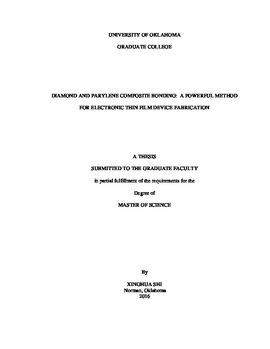| dc.contributor.advisor | McCann, Patrick | |
| dc.contributor.author | Shi, Xinghua | |
| dc.date.accessioned | 2016-05-13T20:37:55Z | |
| dc.date.available | 2016-05-13T20:37:55Z | |
| dc.date.issued | 2016-05-13 | |
| dc.identifier.uri | https://hdl.handle.net/11244/34688 | |
| dc.description.abstract | A new and powerful method for electronic device fabrication is presented. A diamond and parylene composite thin film layer bonding process is described. Two sizes of diamond particles, nominally 0~0.5µm and 0~2µm were used to form different composite bonding layers. Scanning electron microscopy (SEM) images show good bonding quality with no observed voids within the approximately 10 micron thickness of the bonding layer and along about 1 cm of bonded length. In addition, a thin film IV-VI semiconductor material grown by molecular beam epitaxy (MBE) was used to perform thermal conductivity measurements. The technique involved flip chip bonding the IV-VI epitaxial layer to one side of two silicon chips bonded together with the parylene composite film, attaching the other side of silicon chip assembly to a heat sink, and measuring the blue shift in the photoluminescence (PL) emission from the IV-VI epitaxial layer while being illuminated (and heated) with a diode laser. The PL data provided an accurate temperature measurement of the laser-heated surface. This measurement procedure accurately simulates the use of a parylene/diamond composited material in the packaging of high power electronic devices. The amount of heating with a parylene/diamond composite bonding material was 19.5°C, which was significantly lower than the 36.3°C observed for a control sample that was parylene bonded without diamond. These results clearly show that incorporation of diamond particles in parylene can significantly reduce hot spot temperatures in electronic devices. Finite element thermal modeling was used to determine the thermal conductivity of the parylene/diamond composite material using the hot spot temperatures obtained from the PL measurements as boundary conditions. Modeling results showed an improvement factor of 3.6 with incorporation of diamond. This corresponds to a thermal conductivity increase from 0.083 W/mK for bulk parylene to 0.30 W/mK for the parylene/diamond composite material. Moreover, the ability to from a thin bond with a thickness of 10 microns or less provides additional thermal management benefits over other device packaging techniques that involve much thicker bonding layers. Two conclusions can be drawn from this work. The first is that a proof-of-concept has been established for the opportunity to develop an improved electronic device packaging material based on thin film parylene/diamond composites. The second is that thermal conductivities of experimental thin film materials for thermal management applications can be obtained by using photoluminescence measurements of IV-VI semiconductor thin films to determine the boundary conditions for finite element thermal modeling analysis. Continued work using this new method for measuring thin film thermal conductivity and further refinement of parylene/diamond composite materials should result in a new class of electrically insulting materials that can be used to improve the thermal management of high power electronic devices. | en_US |
| dc.language | en_US | en_US |
| dc.subject | Engineering, Electronics and Electrical. | en_US |
| dc.title | DIAMOND AND PARYLENE COMPOSITE BONDING: A POWERFUL METHOD FOR ELECTRONIC THIN FILM DEVICE FABRICATION | en_US |
| dc.contributor.committeeMember | Shi, Zhisheng | |
| dc.contributor.committeeMember | Sigmarsson, Hjalti | |
| dc.date.manuscript | 2016-05-13 | |
| dc.thesis.degree | Master of Science | en_US |
| ou.group | College of Engineering::School of Electrical and Computer Engineering | en_US |
